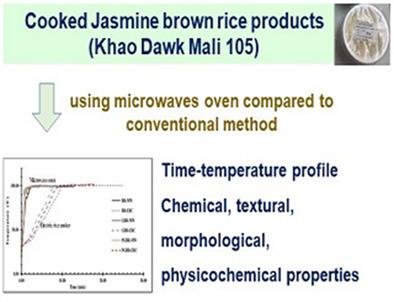当前位置:
X-MOL 学术
›
J. Food Process Eng.
›
论文详情
Our official English website, www.x-mol.net, welcomes your
feedback! (Note: you will need to create a separate account there.)
Effect of conventional and microwave heating on physical and chemical properties of Jasmine brown rice in various forms
Journal of Food Process Engineering ( IF 2.7 ) Pub Date : 2020-08-26 , DOI: 10.1111/jfpe.13506 Nucharee Krongworakul 1, 2 , Onanong Naivikul 1, 3 , Waraporn Boonsupthip 1, 2 , Ya‐Jane Wang 4
Journal of Food Process Engineering ( IF 2.7 ) Pub Date : 2020-08-26 , DOI: 10.1111/jfpe.13506 Nucharee Krongworakul 1, 2 , Onanong Naivikul 1, 3 , Waraporn Boonsupthip 1, 2 , Ya‐Jane Wang 4
Affiliation

|
To study the impact of heating on Jasmine brown rice using microwaves compared to that using conventional method. Morphological, physicochemical properties of uncooked and cooked brown rice samples in native (BR), germinated (GBR) and germinated‐parboiled (PGBR) forms were investigated. It was found that the uncooked rice products had similar macro‐composition (amylose, fat and protein). The microwaves heated the rice four times faster than the conventional way. The cooked grains had large, long, narrow, canal‐like holes on the surface and inner portions. The conventional heating filled the grains with smaller, round holes. Both heating methods created B‐ and V‐type crystals with relative crystallinity of 7–8% at 2θ = 0°–35°, an endothermic peak at 42–61°C with enthalpy (ΔH) of 3–4 J/g, and texture with low hardness and stickiness. However, microwave additionally caused higher pasting temperature and viscosity values, and lower digestibility with higher RS at the expense of RDS and SDS. In terms of the rice forms, PGBR was sensitive to changes in the endothermic peak and digestibility. BR was to changes in the crystallinity, hardness and stickiness. GBR was to pasting properties. Microwave and conventional heating are good methods to diversely modify the properties of rice in various forms. However, diversity was noticed only in some properties.
中文翻译:

常规加热和微波加热对多种形式茉莉糙米理化特性的影响
研究与传统方法相比,微波加热对茉莉糙米的影响。研究了未经煮熟的糙米样品的原始形态(BR),发芽(GBR)和发芽半煮(PGBR)的形态,理化特性。发现未煮过的米制品具有相似的宏观组成(直链淀粉,脂肪和蛋白质)。微波加热大米的速度是传统方式的四倍。煮熟的谷物在其表面和内部具有大,长,窄,类似运河的孔。传统的加热方法是用较小的圆形孔填充谷物。这两种加热方法在2创建的B-和V型结晶用7-8%相对结晶度θ = 0°-35°,在42-61℃的吸热峰与焓(Δ ħ)为3–4 J / g,质地低硬度和低粘性。但是,微波还会导致较高的糊化温度和粘度值,以及较高的RS会降低消化率,但会降低RDS和SDS。就大米形式而言,PGBR对吸热峰和消化率的变化敏感。BR是为了改变结晶度,硬度和粘性。GBR用于粘贴属性。微波和常规加热是改变各种形式大米特性的良好方法。但是,仅在某些属性中才注意到多样性。
更新日期:2020-10-02
中文翻译:

常规加热和微波加热对多种形式茉莉糙米理化特性的影响
研究与传统方法相比,微波加热对茉莉糙米的影响。研究了未经煮熟的糙米样品的原始形态(BR),发芽(GBR)和发芽半煮(PGBR)的形态,理化特性。发现未煮过的米制品具有相似的宏观组成(直链淀粉,脂肪和蛋白质)。微波加热大米的速度是传统方式的四倍。煮熟的谷物在其表面和内部具有大,长,窄,类似运河的孔。传统的加热方法是用较小的圆形孔填充谷物。这两种加热方法在2创建的B-和V型结晶用7-8%相对结晶度θ = 0°-35°,在42-61℃的吸热峰与焓(Δ ħ)为3–4 J / g,质地低硬度和低粘性。但是,微波还会导致较高的糊化温度和粘度值,以及较高的RS会降低消化率,但会降低RDS和SDS。就大米形式而言,PGBR对吸热峰和消化率的变化敏感。BR是为了改变结晶度,硬度和粘性。GBR用于粘贴属性。微波和常规加热是改变各种形式大米特性的良好方法。但是,仅在某些属性中才注意到多样性。











































 京公网安备 11010802027423号
京公网安备 11010802027423号